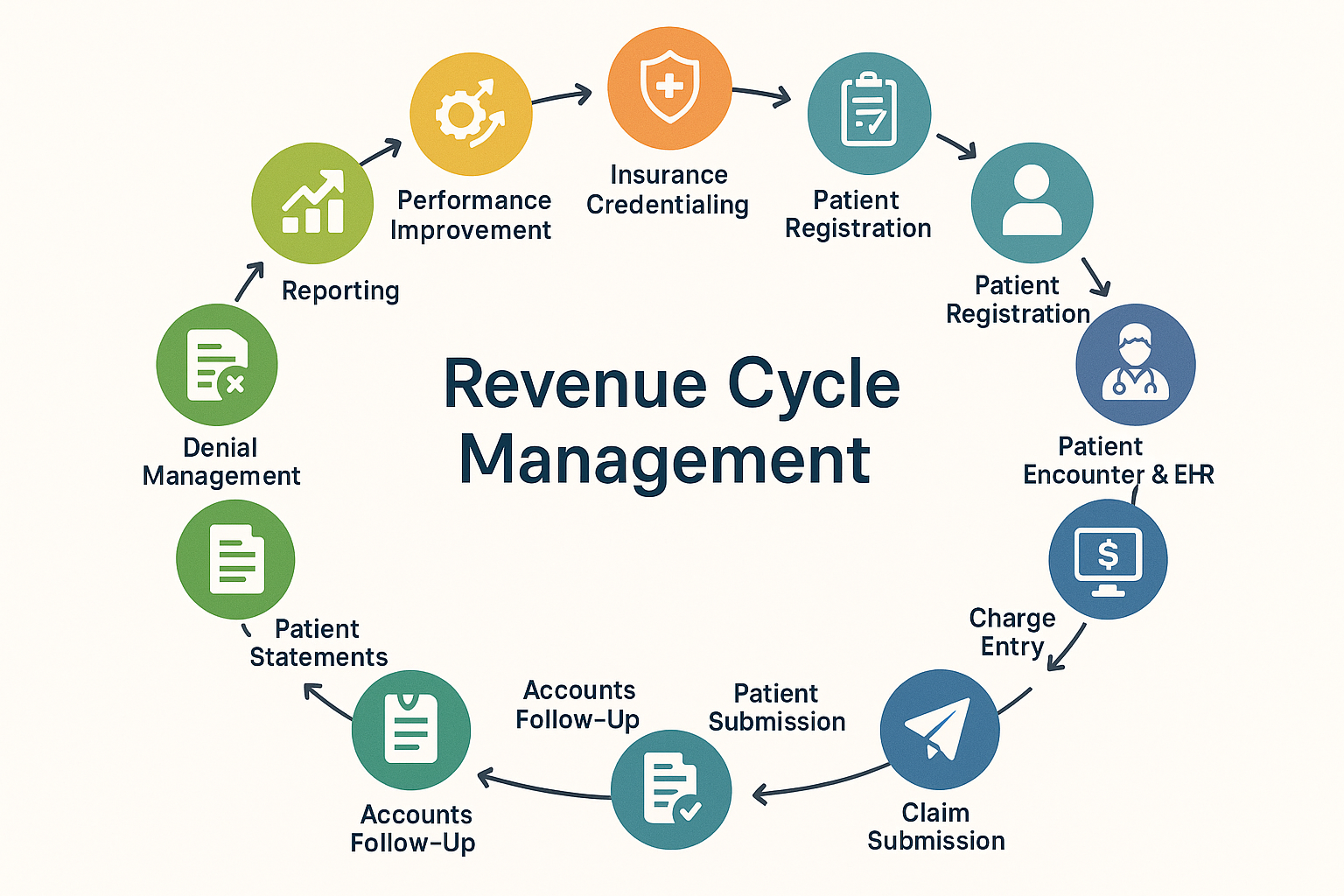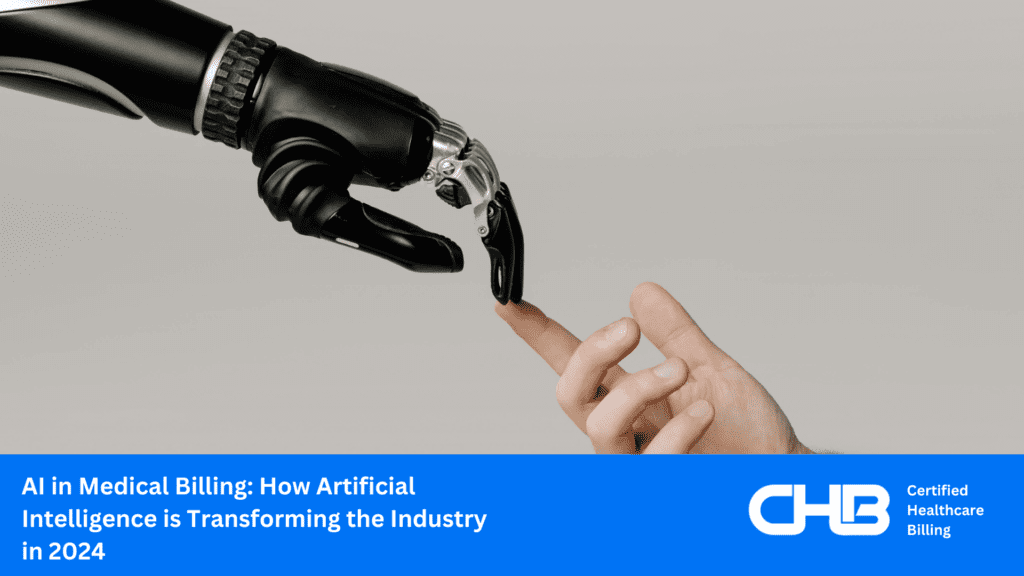What is revenue cycle management?

Hospitals, clinics, and healthcare systems excel at patient care, but maintaining financial health requires robust processes and policies. This is where healthcare revenue cycle management (RCM) becomes essential.
What is revenue cycle management
Revenue Cycle Management (RCM) is how healthcare providers track and collect money for their services.
It covers everything from when a patient schedules an appointment to when their bill is fully paid.
RCM helps doctors and hospitals get paid correctly and on time, so they can focus on taking care of patients.
Basics of Healthcare Revenue Cycle Management
RCM starts when a patient schedules an appointment and ends when all claims and payments are collected. However, the journey of a patient’s account is complex.
When a patient makes an appointment, administrative staff handle scheduling, verifying insurance eligibility, and creating the patient account.
Pre-registration optimizes RCM by capturing accurate medical histories and insurance details upfront.
Entering correct insurance information, verifying patient demographics, and collecting financial responsibility at the start reduce rework and potential denials throughout the revenue cycle.
After the patient visit, the healthcare provider must submit claims and complete charge capture duties.
The provider or coder assigns the appropriate ICD-10 code for the treatment, determining reimbursement from the patient’s health plan. Correct coding helps prevent claim denials.
The charge capture process converts services into billable fees.
Once a claim is created, it is sent to the payer for reimbursement.
However, RCM doesn’t stop there.
Organizations must oversee back-end tasks, including payment posting, statement processing, payment collections, and handling claim denials.
Insurance companies evaluate claims and reimburse healthcare organizations based on patient coverage and contracts. Claims may be denied for reasons such as improper coding or incomplete patient information.
For services not covered by insurance, healthcare organizations must collect payments from patients.
RCM aims to ensure full payment for services as quickly as possible.
However, bills and claims often take time to process. Claims may go back and forth between payers and providers for months until resolved.
During remittance processing, the payer approves or denies the claim.
RCM can be lengthy as patients may not have immediate funds to pay medical bills.
Achieving Success in Healthcare Revenue Cycle Management
Healthcare organizations need to remain profitable to succeed in RCM.
Prioritizing patient access and front-end optimization is critical.
Errors in front-end tasks, such as verifying insurance eligibility, can disrupt claims reimbursement.
Tasks like eligibility verification are crucial to ensuring facilities receive payment from health plans.
Digital engagement has streamlined front-end workflows, proving beneficial during the COVID-19 pandemic.
Digital patient intake allows for contactless registration, which is safer and more convenient.
Effective claim denial management and procedures to resolve reimbursement issues quickly are essential.
Claim denial rates have been rising, with hospitals experiencing an increase from 10.15% in 2020 to 11.99% in 2023.
Additionally, Medicare Advantage denials surged by 56%, and commercial payer denials rose by 20% from early 2022 to mid-2023 (FierceHealthcare).
Avoiding claim denials involves training staff on coding and billing processes, educating patients about medical costs, and investing in automation software.
Regular tracking and investigating causes of denials help prevent future issues.
Outsourcing RCM to a third party can help balance finances and patient care, though it may lead to higher claim denial rates for some hospitals.
Data analytics play a crucial role in successful RCM programs.
With value-based care models, healthcare organizations must report on quality care, patient satisfaction, and costs to receive full reimbursement from payers.
Data analytics help manage information and inform employees of RCM goals through dashboards and alerts.
Analytics can predict claim results by tracking the claim lifecycle.
Challenges in Healthcare Revenue Cycle Management
Maintaining stable RCM policies is challenging with ever-changing healthcare regulations.
Collecting payments from patients at or before the point of service is a top challenge.
Collecting payments before a patient leaves the office can save time and effort but is often difficult.
InstaMed data from 2020 shows that 74 percent of healthcare providers take over a month to collect patient payments.
Many patients struggle to pay medical bills upfront due to high deductibles and financial hardships.
Healthcare organizations must balance collecting payments on time with not driving patients away.
The COVID-19 pandemic has pushed providers to adopt new patient collection strategies.
Some providers have increased payment options or adjusted bad debt placement timing.
Others allow patients to extend payment terms or delay payments.
Coding and charge capture pose significant RCM challenges.
Coding errors by staff can lead to reimbursement issues.
Regular employee training promotes proper coding techniques, comprehensive chart documentation, and financial policy reminders.
Training sessions improve return on investment, lower turnover rates, and reduce medical errors.
Prior authorization processes are another challenge.
Providers must wait for health plan authorization before receiving or providing treatment.
The surprise billing rule under the No Surprises Act has also impacted RCM.
The policy protects patients from surprise billing by preventing out-of-network providers from billing for more than the in-network cost-sharing amount.
Providers must adjust their workflows to comply with this policy, effective January 1, 2022.
How Technology Drives Healthcare Revenue Cycle Management
Health IT and EHR systems have streamlined and refined RCM strategies.
Many organizations use technology to track claims, collect payments, and address claim denials, ensuring a steady revenue stream.
During the COVID-19 pandemic, 75 percent of hospitals deployed RCM technology.
Technology and automation have facilitated remote RCM operations.
Automation helps with payer-provider communications, recommending ICD-10 codes, monitoring billing processes, and scheduling appointments.
Providers are leveraging artificial intelligence (AI) to enhance RCM processes.
AI monitors data and identifies issues like claim denials.
AI and automation also assist with prior authorization requirements.
Healthcare RCM continues to evolve with value-based care, new technology, and a global pandemic.
Professionals should always monitor their revenue cycle to provide appropriate care and receive proper reimbursement.
FAQ
What is revenue cycle management in healthcare?
Revenue cycle management is the process of tracking and managing patient care episodes from registration to final payment.
Why is RCM important?
RCM is crucial because it makes sure of timely reimbursement, reduces claim denials, and improves cash flow.
How does medical coding affect RCM?
Accurate medical coding is essential for correct billing and reimbursement. It translates healthcare services into standardized codes used for insurance claims.
What is denial management?
Denial management involves reviewing and correcting denied claims. It helps recover lost revenue and reduces future denials.
How can Certified Healthcare Billing help with RCM?
Certified Healthcare Billing offers expert RCM services. We provide fast claims submission, reduce claim denials, and improve revenue. Contact us to talk to a specialist.



